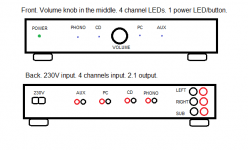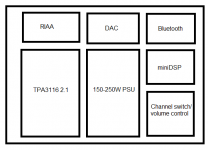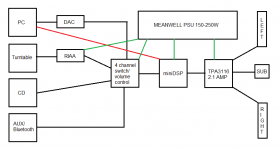Hello fellow DIY'ers!
With the introduction of the new TI TPA3116D2-chip, which seems to be the new IT in class-D, I want to build a complete amp with all the functionalities of a retail version. When I say "build a complete amp", I mean an enclosure which houses a finished TPA3116 board along with several other audio-elements. To make things easier, I'll list below what I have been thinking about. I want you guys to help me determine what elements I need or don't need, and what I should buy to suit these needs. If there other things you think would be beneficial to this build, please let me know.
Keep in mind that I want to do this project for less than $300. I know that doesn't leave a lot of headroom, but I know it can be done. This amp is going to run a pair of Frugel-Horn MK3's, likely with the CHR-70 or CHP-70 drivers, as well as a subwoofer of which kind I have not determined yet. I have made some simple drawings in paint to illustrate my ideas and attached them.
I have a ton of question at the bottom of this post, which are numbered accordingly. If you want to answer or address a certain question, please refer to its number - to keep things tidy. If some questions are too mundane or obvious, please point me in the Google-direction.
Functionalities:
- At least 4 different audio inputs
- 2.1 audio output
- Integrated PSU
- Integrated DAC
- Integrated RIAA
- Integrated miniDSP
- Integrated bluetooth adapter
- Remote control of power, volume and channel
- Status LED's for chosen channel
Aestethics:
- Wooden construction in teak
- Removable top lid for easy access
- Spacious rear for easy connection and access
- Clean and simple front with single volume knob and dimmed LED's.
My choices so far:
- YingJang TPA3116 2.1 2x50W+1x100W finished amplifier board - $32
Questions:
1. miniDSP: I'm a little uncertain whether or not I need the DSP. This will be the single most expensive piece of kit in the build, and I'm not sure how much of an effect it will have. I have read that people have had lots of benefits from these little things. Room-compensation is what springs to my mind. What are your thoughts?
2. PSU: I have asked questions in the TPA3116-thread about powersupply. This chip can run off everything from 4,5V to 26V. Some people say that a generic 12-20V/60-100W laptop SMPS is more than sufficient, while others claim that one should opt for a larger 24V/150-250W supply. What are your thoughts?
3. Remote control/channel switcher: I want the abilitiy to adjust the volume, change input-channel and power the amp on and off from the comfort of my couch. Does anyone know of a good and inexpensive option for this? I want the ability to handle at least 4 channels.
4. RIAA: Can the miniDSP do the job as RIAA-step? If not, I need a cheap and simple board that will do the job for less than $30.
5. DAC: If I am to go for a miniDSP, would I need a DAC at all? A computer will be hooked up to the amp at all times, and as far as I know the miniDSP also works as a DAC. My concern is it will be more difficult to switch channels if I use the miniDSP for DAC'ing. If DAC, what DAC?
6. Bluetooth: I want to easily connect a bluetooth device for casual listening. Does anyone know of a good quality adapter for less than $30?
7. Shielding/wiring: I've seen some custom amp-builds where people twist their cables and add ferrite cores and whatnot. Should I think about this? Is interference from RF and other sources a big issue?
8. Vacuum tubes: So far I've never listened to a tube-amp. They undoubtedly look really cool, however looks are second in line to price and added complexity. Will I gain something by using tubes? What will it cost?
9. Likely more to come...
With the introduction of the new TI TPA3116D2-chip, which seems to be the new IT in class-D, I want to build a complete amp with all the functionalities of a retail version. When I say "build a complete amp", I mean an enclosure which houses a finished TPA3116 board along with several other audio-elements. To make things easier, I'll list below what I have been thinking about. I want you guys to help me determine what elements I need or don't need, and what I should buy to suit these needs. If there other things you think would be beneficial to this build, please let me know.
Keep in mind that I want to do this project for less than $300. I know that doesn't leave a lot of headroom, but I know it can be done. This amp is going to run a pair of Frugel-Horn MK3's, likely with the CHR-70 or CHP-70 drivers, as well as a subwoofer of which kind I have not determined yet. I have made some simple drawings in paint to illustrate my ideas and attached them.
I have a ton of question at the bottom of this post, which are numbered accordingly. If you want to answer or address a certain question, please refer to its number - to keep things tidy. If some questions are too mundane or obvious, please point me in the Google-direction.
Functionalities:
- At least 4 different audio inputs
- 2.1 audio output
- Integrated PSU
- Integrated DAC
- Integrated RIAA
- Integrated miniDSP
- Integrated bluetooth adapter
- Remote control of power, volume and channel
- Status LED's for chosen channel
Aestethics:
- Wooden construction in teak
- Removable top lid for easy access
- Spacious rear for easy connection and access
- Clean and simple front with single volume knob and dimmed LED's.
My choices so far:
- YingJang TPA3116 2.1 2x50W+1x100W finished amplifier board - $32
Questions:
1. miniDSP: I'm a little uncertain whether or not I need the DSP. This will be the single most expensive piece of kit in the build, and I'm not sure how much of an effect it will have. I have read that people have had lots of benefits from these little things. Room-compensation is what springs to my mind. What are your thoughts?
2. PSU: I have asked questions in the TPA3116-thread about powersupply. This chip can run off everything from 4,5V to 26V. Some people say that a generic 12-20V/60-100W laptop SMPS is more than sufficient, while others claim that one should opt for a larger 24V/150-250W supply. What are your thoughts?
3. Remote control/channel switcher: I want the abilitiy to adjust the volume, change input-channel and power the amp on and off from the comfort of my couch. Does anyone know of a good and inexpensive option for this? I want the ability to handle at least 4 channels.
4. RIAA: Can the miniDSP do the job as RIAA-step? If not, I need a cheap and simple board that will do the job for less than $30.
5. DAC: If I am to go for a miniDSP, would I need a DAC at all? A computer will be hooked up to the amp at all times, and as far as I know the miniDSP also works as a DAC. My concern is it will be more difficult to switch channels if I use the miniDSP for DAC'ing. If DAC, what DAC?
6. Bluetooth: I want to easily connect a bluetooth device for casual listening. Does anyone know of a good quality adapter for less than $30?
7. Shielding/wiring: I've seen some custom amp-builds where people twist their cables and add ferrite cores and whatnot. Should I think about this? Is interference from RF and other sources a big issue?
8. Vacuum tubes: So far I've never listened to a tube-amp. They undoubtedly look really cool, however looks are second in line to price and added complexity. Will I gain something by using tubes? What will it cost?
9. Likely more to come...
Attachments
Hi Big.
I am at the beginning of a similar idea so look forward to your solutions, but unfortunately don't have much to add. Except that I would avoid using the MiniDSP unless really needed.
Not that it can't do many amazing things, just that it adds complications of its own and I believe (after using it) will cause a drop in SQ in what should be a reasonably revealing system.
Perhaps you could try the amp and speakers together first and add other parts as needed. Just to get a reference. The mini can act as any type of filter needed but would require PC connection and filter upload for each change. Keep in mind that the onboard USB connection does not transmit audio, you will need a separate ministreamer for that function.
The input's can be switched with an analogue selector switch connected to the MiniDSP.
Hope it goes well.
Dean
I am at the beginning of a similar idea so look forward to your solutions, but unfortunately don't have much to add. Except that I would avoid using the MiniDSP unless really needed.
Not that it can't do many amazing things, just that it adds complications of its own and I believe (after using it) will cause a drop in SQ in what should be a reasonably revealing system.
Perhaps you could try the amp and speakers together first and add other parts as needed. Just to get a reference. The mini can act as any type of filter needed but would require PC connection and filter upload for each change. Keep in mind that the onboard USB connection does not transmit audio, you will need a separate ministreamer for that function.
The input's can be switched with an analogue selector switch connected to the MiniDSP.
Hope it goes well.
Dean
Thank you Dean. I agree with you - if I am to add the DSP, it will have to be after I've tested the system without it first.
You could do the RIAA in MiniDSP, but you also need more gain, since cartridges have very low gain. There is also more to RIAA than just frequence correction. You also need impedance matching and preferably gain adjustment.
Here is a link to a fairly cheap RIAA (40$ for a full kit - cheaper if you can get parts cheaper yourself)
RJM Audio - Printed Circuit Boards
Here is a link to a fairly cheap RIAA (40$ for a full kit - cheaper if you can get parts cheaper yourself)
RJM Audio - Printed Circuit Boards
By the way - a RIAA is very very sensitive to noise, so you might get in trouble having all that (switching) noise next to the RIAA.
Sorry to raise your post from the dead Big SturL, but did you ever finish this project? I'm about to build my own as well, and am curious to see how it turned out.
- Status
- Not open for further replies.
- Home
- Amplifiers
- Class D
- Help me build a TPA3116-based amp


